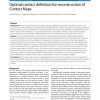100 search results - page 13 / 20 » Predicting protein folds with structural repeats using a cha... |
BMCBI
2004
13 years 7 months ago
2004
Background: Hidden Markov Models (HMMs) have proven very useful in computational biology for such applications as sequence pattern matching, gene-finding, and structure prediction...
BMCBI
2010
13 years 7 months ago
2010
Background: Contact maps have been extensively used as a simplified representation of protein structures. They capture most important features of a protein's fold, being pref...
RECOMB
2004
Springer
14 years 8 months ago
2004
Springer
Finding recurring residue packing patterns, or spatial motifs, that characterize protein structural families is an important problem in bioinformatics. To this end, we apply a nov...
BMCBI
2006
13 years 7 months ago
2006
Background: When accurate models for the divergent evolution of protein sequences are integrated with complementary biological information, such as folded protein structures, anal...
BMCBI
2007
13 years 7 months ago
2007
Background: Matching functional sites is a key problem for the understanding of protein function and evolution. The commonly used graph theoretic approach, and other related appro...

